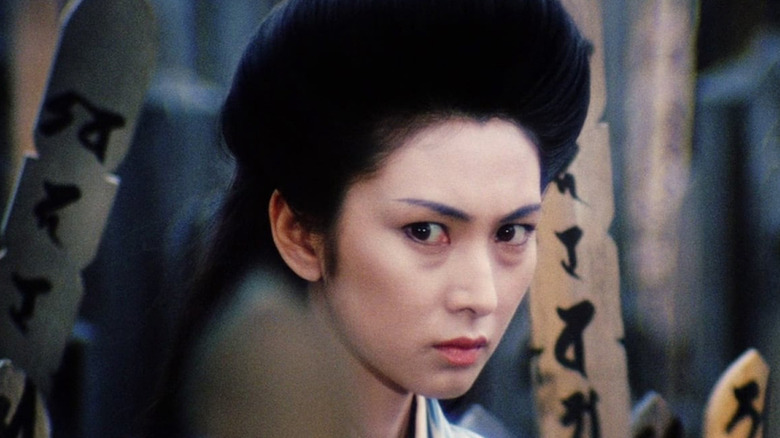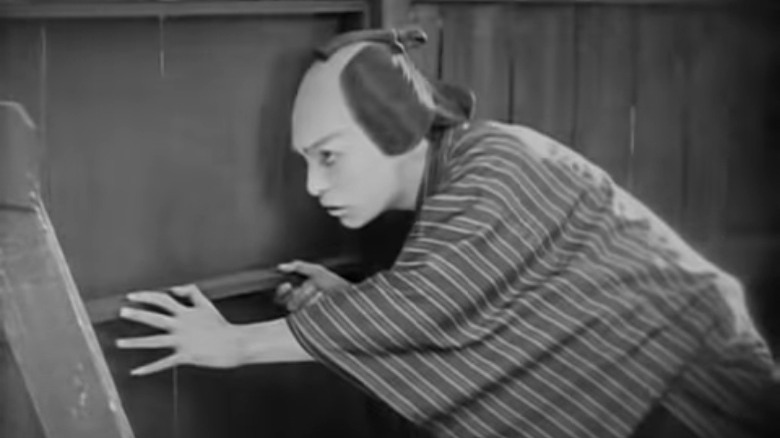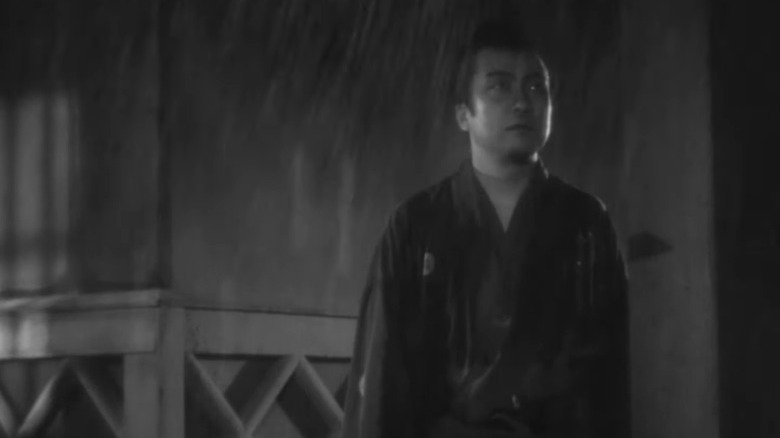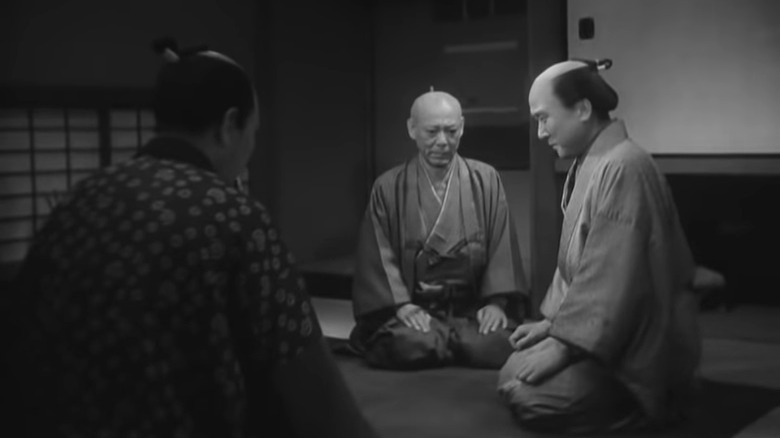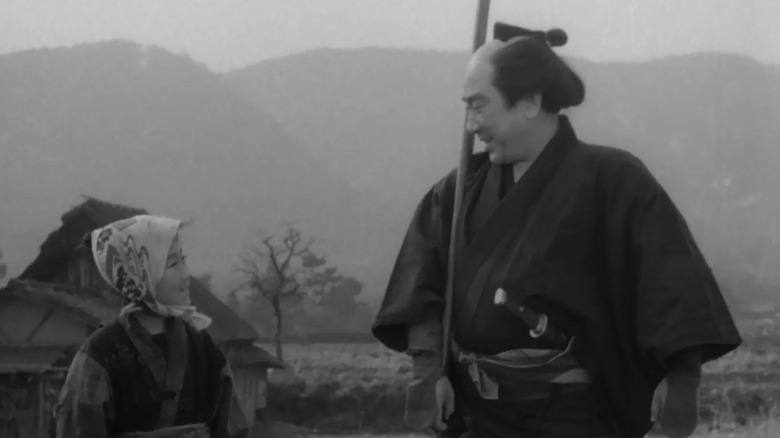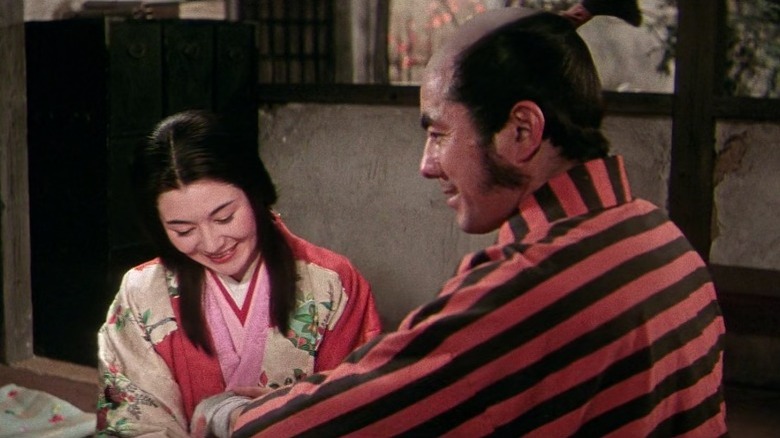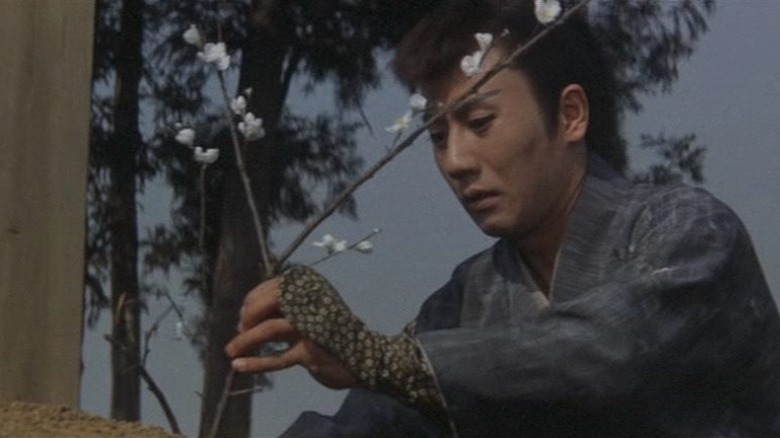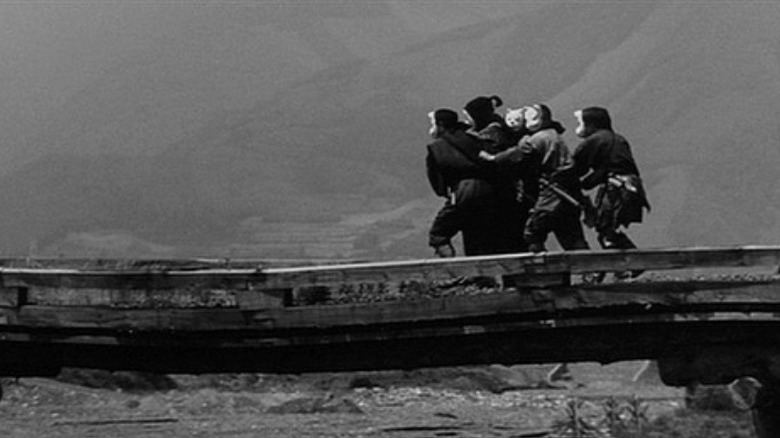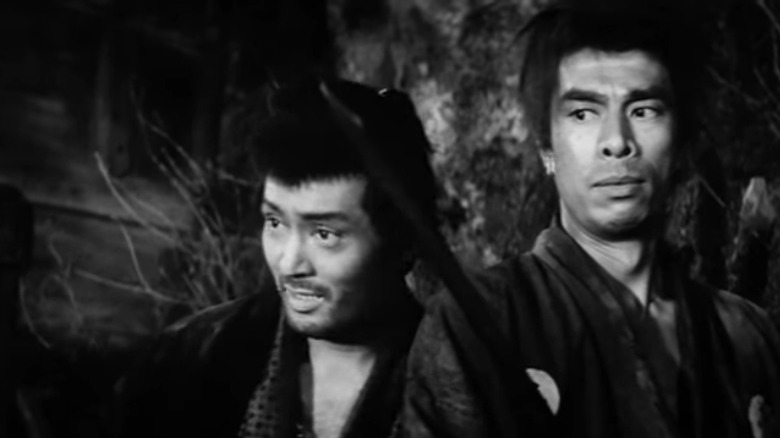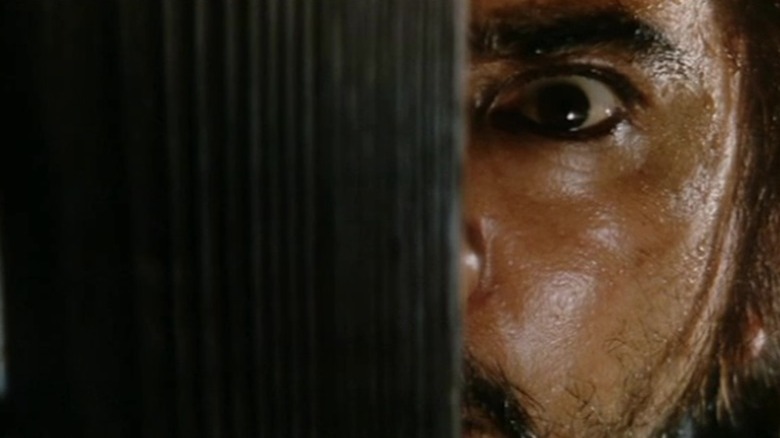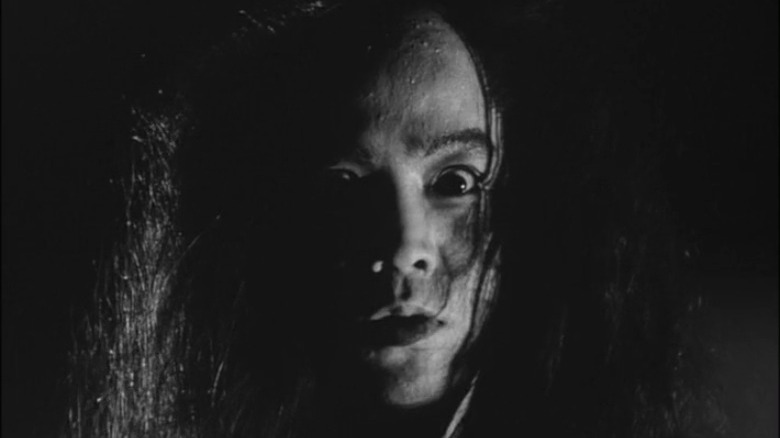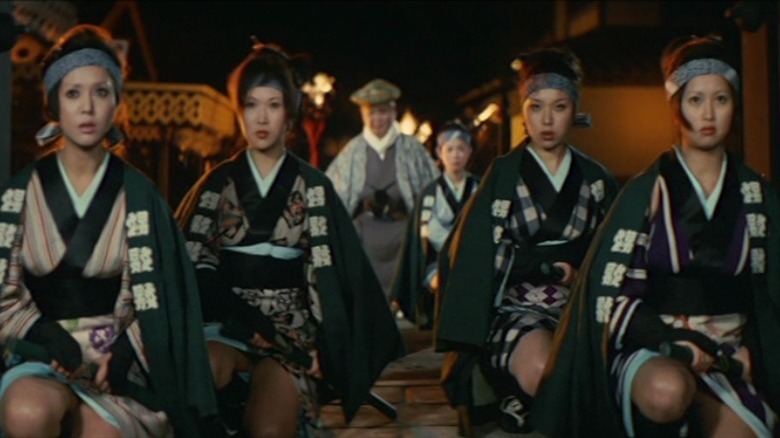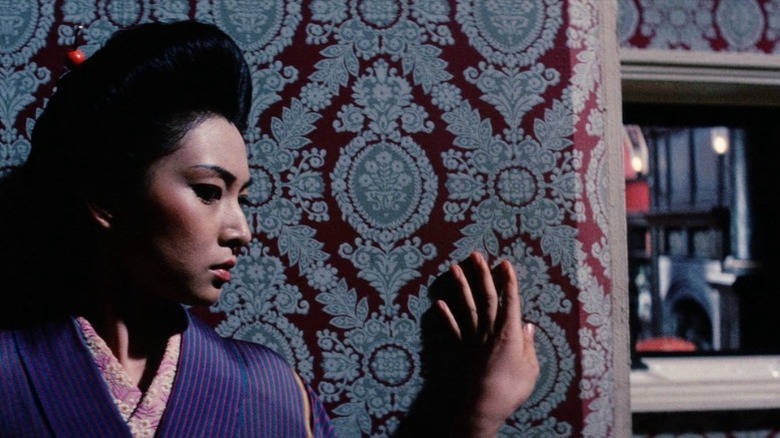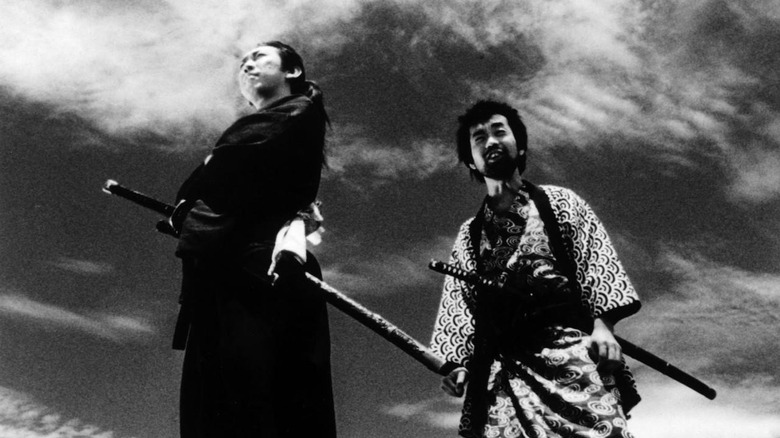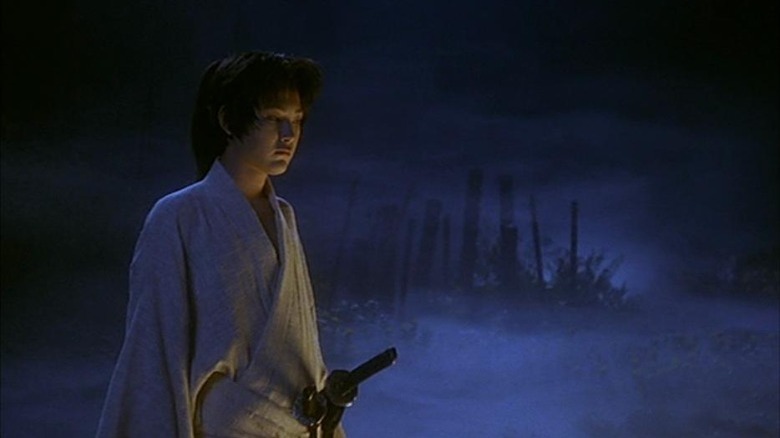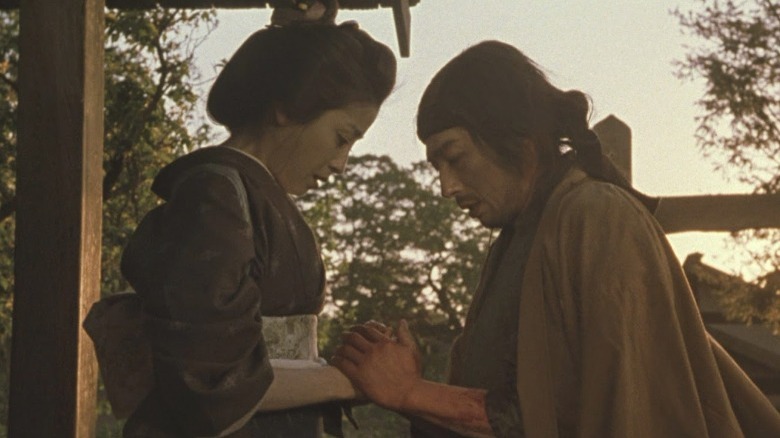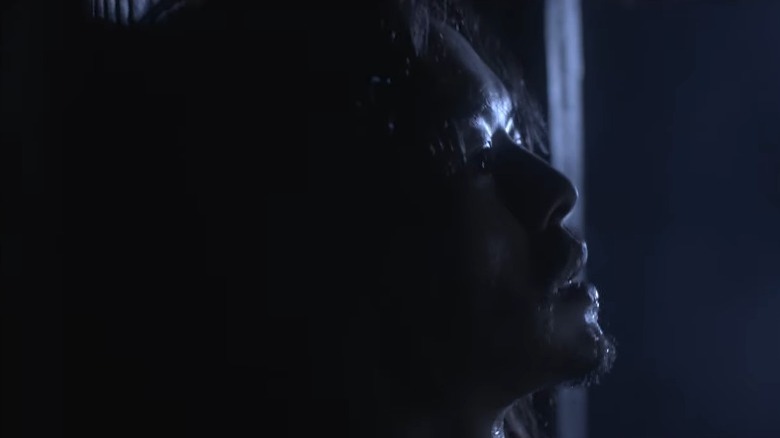16 Underrated Samurai Movies You Need To Watch
Samurai films — also sometimes called sword fight films and referred to by the Japanese-language term "chanbara" — have been one of the pillars of Japan's film production for pretty much the entirety of its history. The image of the samurai has attracted the fascination of filmmakers working in the jidaigeki (period film) genre for decades: The ghost incarnate of a shared national past, at once refined nobleman and ruthless slayer, carrying with him bygone shadows of both honor and inequality, duty and despotism, glory and gore. That image yielded some of the most towering masterpieces in all of cinema.
Those masterpieces have been, incidentally, quite varied. After all, the samurai was never just one "thing" at one time for pre-Modern Japanese society. Their heyday spanned nearly 700 years and five different historical periods (via Japan Guide). The one thing chanbara films universally have in common is the central presence of the swashbucklers themselves, who have appeared in every cinematic disposition you could name, from stately drama to feverish horror to probing eroticism to whimsical comedy of manners. Even the genre's grand patron himself, Akira Kurosawa, didn't limit himself to just one kind of samurai movie. In other words, if you're someone with an interest in chanbara who's already gotten through the mandatory classics and popular favorites (including Kurosawa's), buckle up because the journey is just getting started. In chronological order, here are 16 underrated samurai movies you need to watch.
Serpent (1925)
One of the most charismatic and skilled swordsmen in chanbara history was silent cinema star Tsumasaburō Bandō, who in 1925 made history by founding his own studio, Bantsuma Productions. In addition to showcasing Bandō at the top of his form, the most celebrated and beloved Bantsuma film, Buntaro Futagawa's "Serpent," also stands out as a crucial time capsule.
Although it's a samurai film, the protagonist Heizaburo (Bandō) is a far cry from the stately noblemen of traditional samurai stories. Brash, lower-class by background, and repeatedly beaten down by a cruel aristocratic world, Heizaburo embodies the wronged little guy who had become increasingly prevalent in the Japanese political imagination during the period of liberalized "Taishō democracy." The same progressive attitude that brewed the film also brewed a backlash, and "Serpent" wrapped up just as right-wing conservatives were once again gaining ground in government. Futagawa and Bandō were ultimately forced to cut and reshoot several scenes (and rename the film from its originally intended title "Outlaw"), but all that fuss had the unintended consequence of drumming up public curiosity. When audiences flocked to theaters to see the final result, they were presented with something unmistakably subversive even in sheared-down form. "Serpent" became a sensation, with Bandō's underdog hero recentering the samurai's moral fiber — irrespective of social standing and militaristic glories — as the real source of his enduring popular appeal. It's a movie that leaves you gaping even today.
Humanity and Paper Balloons (1937)
In the years leading up to World War II, samurai cinema wasn't yet clearly delineated as the hot-blooded, action-and-adventure-heavy pop genre it would come to be known as in the West. Back then, many directors thought of samurai films primarily as a subset of period drama. For these directors samurai were a subject to be explored rather than defining a whole cinematic mode unto itself.
One of the great jidaigeki masterworks, Sadao Yamanaka's "Humanity and Paper Balloons," is nominally about an impoverished Edo-era ronin, his gambler neighbor, and the two men's efforts to make ends meet. Yet it's really about the brutal indifference towards the disenfranchised festering at the core of the Japanese temperament, and about the impossibility of escaping penury that held sway for centuries under the feudal system. It spotlights the ultimate meaninglessness and vanity of "glorious" institutions like the bushidō system. Most of all, it's a proto-genre vision with a radical matter-of-factness in portraying the samurai as a profession as liable to the winds of money and power as any other. While encompassing all those things, it is also about Japan in the 18th century as well as the increasingly militarized and nationalistic 1930s. It was Yamanaka's last film before he got drafted and died in Manchuria a year later at 28, but it stands as a document of his trailblazing genius.
The 47 Ronin (1941)
Kenji Mizoguchi is one of the greatest legends in all of worldwide cinema history, a man revered and respected enough to have influenced such wide-ranging auteurs as Victor Erice, Theo Angelopoulos, Orson Welles, and Jacques Rivette. That assessment doesn't even factor into his nearly deity-like status in Japan, but even he wasn't immune to the whims of the Japanese military government during World War II. In the 1940s, the famously left-leaning Mizoguchi was poached to direct nationalistic films in support of the ongoing pro-war propaganda campaign, and from that contradictory matrix came one of his most peculiar works: The two-part film "The 47 Ronin."
Although adapted from a historical episode rife with jingoistic potential, "The 47 Ronin" is not an out-and-out pro-war film. Assigned the famous story of the band of ronin who avenge the death of their master in 18th-century Japan, Mizoguchi steered away from the glorified violence and reactionary nostalgia the Japanese military expected him to emphasize. He instead set out to craft a sober, detailed, historically accurate epic drama grappling with the moral impasses presented by the 47 ronin's mission. With nearly the entire film consisting of dense conversation scenes, Mizoguchi made a cerebral dive into the story's traditional themes of honor and sacrifice, appeasing the government without falling in with its morale-boosting aims. It's a film that should be taken with many grains of salt, but visually and dramatically it's a crucial volume in the Mizoguchi oeuvre.
Bloody Spear at Mount Fuji (1955)
Samurai movies weren't always strictly and necessarily "samurai movies." In fact, many of the best films focused on the theme of samurai dutifully steered clear of being any one specific "thing," as masterfully exemplified by Tomu Uchida's "Bloody Spear at Mount Fuji."
Set in the Edo period like most chanbara, this 1955 film avails itself of a broad palette of genres and tones in order to do justice to its picaresque, largely episodic story. Our throughline is Sakawa Kojūrō (Eijirō Kataoka, credited as Teruo Shimada), a samurai with a drinking problem who is traveling the country towards Edo (as Tokyo was known at the time) alongside his two loyal servants named Genta (Daisuke Katō) and Genpachi (Chiezō Kataoka). On the way, the trio meets a series of unique characters going through various predicaments, from a young woman about to be sold into prostitution to an orphan boy with dreams of donning the samurai gusoku himself. Although the film's breezy tone and plentiful comedic imagination ensure that all the characters in the ensemble feel fresh and compelling, Uchida and the writers gradually organize the road-movie sprawl into a sharp exposé of Edo-era society and its many ills. One of the chief ills is samurai life itself, which is presented as a tragic cascade of elitism, destructive masculinity, and senseless violence. It's hilarious, it's delightful, it's gut-wrenching, and it's not to be missed.
Samurai Saga (1959)
Just as Akira Kurosawa's name is synonymous with the chanbara genre, so too is Toshiro Mifune's figure arguably its most indelible symbol. The legendary actor became known worldwide as 20th-century cinema's definitive swordsman, and any of his classic collaborations with Kurosawa readily demonstrate why. No one else had the poise, the agility, the tragic effervescence of Mifune, but if you're at all familiar with the man's oeuvre you know that his skillset as an actor reached far and wide. As "Samurai Saga" (also known as "Life of an Expert Swordsman") demonstrates, it included a flair for comedy, and even for romantic gallantry.
Directed by Hiroshi Inagaki, best-known in the West for his more conventional Oscar-winning "Samurai" trilogy (also starring Mifune), "Samurai Saga" is maybe the last thing you'd expect to find in a chanbara context: A "Cyrano de Bergerac" reimagining. Mifune stars as the samurai Heihachiro Komaki, who fulfills the role of the Cyrano analog, complete with an oversized nose ... not that this succeeds in making him look much less appealing. The film follows the plot of the original Edmond Rostand play pretty closely, with all the elaborate farce and sweeping romance that made it legendary. Rendered in gorgeous Technicolor, it features such fellow icons as Yōko Tsukasa and Akira Takarada rounding out the cast, but the main attraction is Mifune at the top of his craft throwing himself into a role he was positively born to play.
Destiny's Son (1962)
Director Kenji Misumi is one of the most celebrated in the history of samurai cinema, thanks to two landmark achievements that would individually make any filmmaker legendary: Creating the "Lone Wolf and Cub" film series (directing four out of six installments), and helming the inaugural entry in the long-running "Zatoichi" franchise, 1962's "The Tale of Zatoichi." The same year that the latter film came out, Misumi also released "Destiny's Son," a lesser-known chanbara film that arguably stands as an even greater artistic achievement.
Although a mere 71 minutes long and minimalistic in narrative structure, "Destiny's Son" manages to pack in enough excitement, visual splendor, and thematic reflection for 10 movies. The plot, to the extent that it matters, follows the twists and turns that befall a swordsman (Raizo Ichikawa) as he sets out to learn the truth about his past and avenge the death of his mother (Shiho Fujimura), an assassin who was killed by her own executioner husband (Shigeru Amachi). As scribed by the avant-garde master Kaneto Shindo, "Destiny's Son" just barely falls within the bounds of conventional narrative cinema. It's a film in which Misumi puts his vision and sense of poetry as a stylist in service of a stark, elemental, altogether sublime experience, the greatness of which is easier to witness than to summarize.
Samurai Spy (1965)
A bulletproof premise — samurai and spies, whaddaya need, a road map? — is given a typically oblique treatment by the ever-unassailable Masahiro Shinoda in "Samurai Spy." It was made at the height of the Cold War, whose effects were felt on Japanese soil at the time in the country's increasingly controversial diplomatic and military ties with the U.S., as well as the changes in its relationship with the neighboring Korean Peninsula. "Samurai Spy" is one of those period films that are really just as concerned with the present as with the past. In fact, if what you want is a straightforward, swashbuckling good time, you might want to put this one on hold, as it is much closer to political noir territory than typical chanbara.
Set in the 17th century, "Samurai Spy" charts the web of lies and double-crossings that begin to unspool in Japan in the early years of the Tokugawa shogunate, as the ruling Tokugawa clan finds its hegemony threatened on all sides by rival groups. Although there are combat and fight scenes in the film, they are decidedly few and far between compared to the majority of samurai films. Instead of high-octane action, Shinoda angles for suspense and paranoia, tracking the furtive movements of samurai and ninjas as one would pieces on a massive chessboard. As is often the case with great noir, don't expect to keep track of everything, but the gamesmanship speaks for itself.
Kill! (1968)
It is often said that spaghetti western films — which, incidentally, owe a lot to chanbara cinema in their own right — are best enjoyed by viewers who have a certain familiarity with the history of "traditional" westerns being deconstructed and commented upon. The same is true of Kihachi Okamoto's "Kill!" Perhaps not beholden to a canon rigid and ruly enough to accommodate "spaghetti chanbara," it does strike a similarly rewarding balance between ribbing and reverence.
"Kill!" stars Tatsuya Nakadai and Etsushi Takahashi as, respectively, a man who's long grown weary of samurai life and another who longs to join it and bask in its social gains. Through a series of unlikely circumstances, they become embroiled in a bloody turf war between members of a local clan, ultimately joining a band of rebels as they face a siege ordered by their former superior. The film takes on a typically gruesome quality as the rebels fight tooth and nail for their survival, but what's not typical at all is its campy, humorous, quasi-parodic tone. Not only are the bushidō codes irreverently skewered and the eruptions of violence deliriously exaggerated, but the very characters in the ensemble work as plays on classic chanbara archetypes. It's a love letter to the genre that's sure to be great fun even for the uninitiated and to spark all kinds of recognition in samurai aficionados.
Hitokiri (1969)
There are so many brilliant filmmakers in Japanese cinema relatively unknown to Western audiences that you could make entire lists just for names belonging to each genre, including chanbara. The most unsung of chanbara directors may be Hideo Gosha. His most famous film internationally is 1964's "Three Outlaw Samurai," a staple of samurai movie marathons but there is much more to discover in Gosha's oeuvre.
Like all chanbara masters, Hideo Gosha understood that the most fascinating thing about samurai wasn't their swordsmanship or their cold-bloodedness, but the complex, ever-shifting role they played in the continuum of Japanese social and cultural history. He grappled directly with that role, as well as its many psychological repercussions, in the 1969 character study "Hitokiri," released as "Tenchu!" in the U.S. and listed as such on some databases. Here, the same Shintarō Katsu who became iconic as the stately Zatoichi plunges himself into the role of a man driven to moral rot by samurai duty. It's an interpretation of the infamous real-life elite assassin Okada Izō, who in this film shares the screen with his three fellow Hitokiri of the Bakumatsu (one of whom is played by Yukio Mishima, in a rare acting role). There may be no other film that confronts the inherent soul-eating horror of assassin life, with all the attending implications about Japan's institutional past, in such a fearless or clear-eyed way.
Demons (1971)
"Demons" — sometimes known in English as "Pandemonium" — is a film that understands two things: First, the potential for all-out, uncut, nightmare-inducing horror immanent in Shakespearean grand tragedy. Second, the all-consuming darkness of the soul that exists as a corollary to any lifestyle is fundamentally tied to violence. As such, this criminally under-discussed masterpiece from the great video artist and avant-garde filmmaker Toshio Matsumoto (best-known for his queer classic "Funeral Parade of Roses") is possibly the best example of a subgenre that should make the rounds more often: samurai horror.
"Demons" follows Gengobe Satsuma (Katsuo Nakamura), a disgraced ronin torn between two paths: Using the 100 ryō collected by his servant to buy his way into the famed party of the 47 ronin, thereby nominally restoring his honor, or using them to prevent Koman (Yasuko Sanjo) — a geisha he's desperately in love with — from being sold to another man. The decision he ultimately makes sends him down a path of revenge so vicious and mutually destructive it defies comprehension. Even summarizing the film's plot is nowhere near enough to get across its sheer intensity as a cinematic experience. An artist accustomed to bending the plasticity of the moving image to his will, Matsumoto cuts to the heart of Gengobe's blight not with literary devices but with aesthetics, rendering the entirety of the film — from its oppressively bleak lighting to its destabilizing editing to its hallucinatory gore — as an unbridled descent into hell.
Bohachi Bushido: Code of the Forgotten Eight (1973)
To understand the history of any nation's film production, you have to understand its exploitation films. The same is very much true of Japan, which became famous among sleazes the world over in the second half of the 20th century as one of the leading hubs for, shall we say, uninhibited cinema. Japanese filmmakers proved particularly crucial to the international lexicon of exploitation cinema due to the way that they integrated ero guro (an artistic tradition emphasizing the harrowing and bizarre side of erotica) into their skin flicks. This style even gained its own unique name: pinku eiga or "pink films."
One of the most important auteurs of pink films was Teruo Ishii, whose work at Toei includes some of the most notorious amalgams of horror and horniness in all of world cinema. He didn't limit himself to horror, and indeed one of his major works consists of an effort to lewd up a whole other signature genre. The Japanese title of "Bohachi Bushido: Code of the Forgotten Eight" gives it all away: "Poruno jidaigeki," literally meaning "Porno period film." The plot, in which a world-weary samurai is rescued from suicide by a clan of ronin turned amoral hustlers and begins to do their bidding in a sex trade war, is just the entry point into a typically over-the-top cauldron of action, sex, nudity, acrobatics, and dashing colors that doubles as genuinely well-done chanbara.
Lady Snowblood 2: Love Song of Vengeance (1974)
Obviously, 1973's totemic "Lady Snowblood" would never belong on any list of "underrated" films, enjoying the status of one of the most unanimous masterworks in samurai film history. However, its oft-forgotten sequel released just a year later, which brought back both director Toshiya Fujita and star Meiko Kaji, does seem to slip through the cracks more often than it should.
Perhaps the reason "Love Song of Vengeance" doesn't get as much attention as its high-octane, Quentin Tarantino-aped predecessor is that it's comparatively short on flashy pop thrills. Working from an original story (as opposed to the manga series by Kazuo Koike and Kazuo Kamimura), director Toshiya Fujita pares down the first film's iconic geysers of blood and elaborate standoffs, which get mostly confined to the final 30 minutes. In their place, the movie offers suspense, sprawling plotting, and oodles of political intrigue, as well as even more overt and incendiary anti-imperialist undertones. This time around, our assassin heroine Yuki Kashima is arrested and sentenced to death, only for Japan's Meiji-era secret police to offer her a deal: She will be spared if she infiltrates and offers intel on a group of anarchist "enemies of the state." Naturally, it doesn't take long for Yuki's allegiances to be tested, nor for her to get caught up in the era's perilous cat-and-mouse games between cops and revolutionaries.
Samurai Fiction (1998)
If you want to get a glimpse of what chanbara looks like filtered through the grungy, meta-reflexive postmodern gaze of '90s indie cinema, look no further than "Samurai Fiction." It is the feature directorial debut from Hiroyuki Nakano, who earned his stripes as a music video director on MTV Japan for artists like Deee-Lite and Tomoyasu Hotei (the latter makes his acting debut in the film). The original plan was for "Samurai Fiction" to be the first entry in a series of films titled "SF," which would comprise multiple loosely-related genre exercises all sharing the same initials. Ultimately, only two "SF" features were released, with all the entries after 2001's "Stereo Future" being short films. That doesn't take away from the achievement of "Samurai Fiction," which showcases all the energy, imagination, and cultural shrewdness Nakano honed in his music video career.
In some ways, it is a precursor to Western genre pastiches like "Kill Bill," imbuing a classic chanbara story (a samurai-in-training journies to retrieve a stolen sword) with the sensibility of a studious fan looking back on the genre's history. Shot mostly in black-and-white, with color reserved for a few choice moments of visual aggression, the film contains multiple nods to samurai films past, all set to one of the most memorable soundtracks ever put to chanbara, a counterintuitive prog-rock symphony supplied by Hotei himself.
Taboo (1999)
When you've made a film as radical and searing as "In the Realm of the Senses," it's only natural for it to be the first thing people associate you with. Yet Japan's provocateur par excellence Nagisa Ōshima has many, many more achievements to his name. For one thing, he certainly didn't stop at making just heterosexual desire shocking and institution-torching, as his final film "Taboo" (also known by its original title "Gohatto") aptly demonstrates.
A film located within the ample and rich history of queer samurai fiction, "Taboo" offers a classic Ōshimian view of sex as a function of culture, society, and all the repressive mechanisms and self-delusions therein. It's very pointedly set in the final years of the Edo period when special police known as the Shinsengumi were tasked with protecting the increasingly disempowered officials of the Tokugawa shogunate. Many chanbara films throughout history have depicted the Shinsengumi in an honorable light, as a kind of final stronghold of traditional samurai values, but "Taboo" views them as something else entirely: desperately horny men. In the plot, the entry of the young and beautiful Kanō Sōzaburō (Ryuhei Matsuda) into the force's ranks triggers a shockwave of bottled-up desire in both his peers and his superiors, turning the training room into a battleground of sexual overtures. The film examines the fault lines and contradictions of bushidō masculinity like no other and in a way candid and sensually charged enough to remain startling to this day.
The Twilight Samurai (2002)
Leave it to Yoji Yamada ("The Yellow Handkerchief") to make a contemporary samurai film that harkens back to the genre's earlier, drama-focused days. An altogether beautiful film that's sure to win over chanbara devotees and skeptics alike, "The Twilight Samurai" tells one of the most soulful and human stories to have come out of jidaigeki cinema in the 21st century so far.
Hiroyuki Sanada stars as Seibei Iguchi, a low-ranking samurai who has just recently lost his wife to tuberculosis. He struggles to put food on the table for himself, his two young daughters, and his elderly mother on a meager grain warehouse worker's salary. The movie takes its time detailing the hardships faced by those at the low end of the feudal pecking order, even samurai. Then, when Seibei's childhood friend Tomoe Iinuma (Rie Miyazawa) comes back to town and reconnects with him, "The Twilight Samurai" becomes a melancholy-tinged romance in addition to a social drama. All in all, the film sensitively takes stock of a very particular dilemma brought on by the transformations in 19th-century Japanese society: When the feudal system is all but crashing down, when the institutions honored and protected by old codes of conduct are gradually ceasing to exist, when samurai life itself is no better than the daily grind of any underprivileged worker, what does an honorable life look like for someone like Seibei? Yamada's patient search for an answer provides a touching cap to decades of chanbara history.
Killing (2018)
As this list has hopefully made clear, the importance of samurai cinema in Japan is great enough to have inspired filmmakers of all persuasions to make their own contributions to the genre. This was once again demonstrated recently by "Killing," a 2018 chanbara film that played in competition at the 75th Venice Film Festival. "Killing" is a rare foray into jidaigeki by Shinya Tsukamoto, who became famous worldwide as the mastermind behind such twisted, queasy J-horror classics as "Tetsuo: The Iron Man" and "Kotoko."
Although it doesn't feature any overt horror elements, "Killing" is just as twisted and queasy in its own way as Tsukamoto's most famous films. The title sums up the film's main preoccupation: Just what does it mean, and what does it take, to kill? Such is the question faced by Tsuzuki (Sosuke Ikematsu), a young ronin who is suddenly yanked from his relatively quiet life as a farmer's assistant when his village gets caught up in the country's brewing civil war. A peaceful man who has never actually killed anyone, Tsuzuki tries as hard as he can to escape the encroaching maelstrom of senseless violence, but the bloody tide of history may just be too strong to resist. Shot in an unusual shaky-cam style, which imprints an extra layer of anxiety and panic onto Tsuzuki's heady existential conflict, "Killing" finds Tsukamoto working as screenwriter, director, editor, cinematographer, and co-star all in service of an indefatigably original take on the genre.
